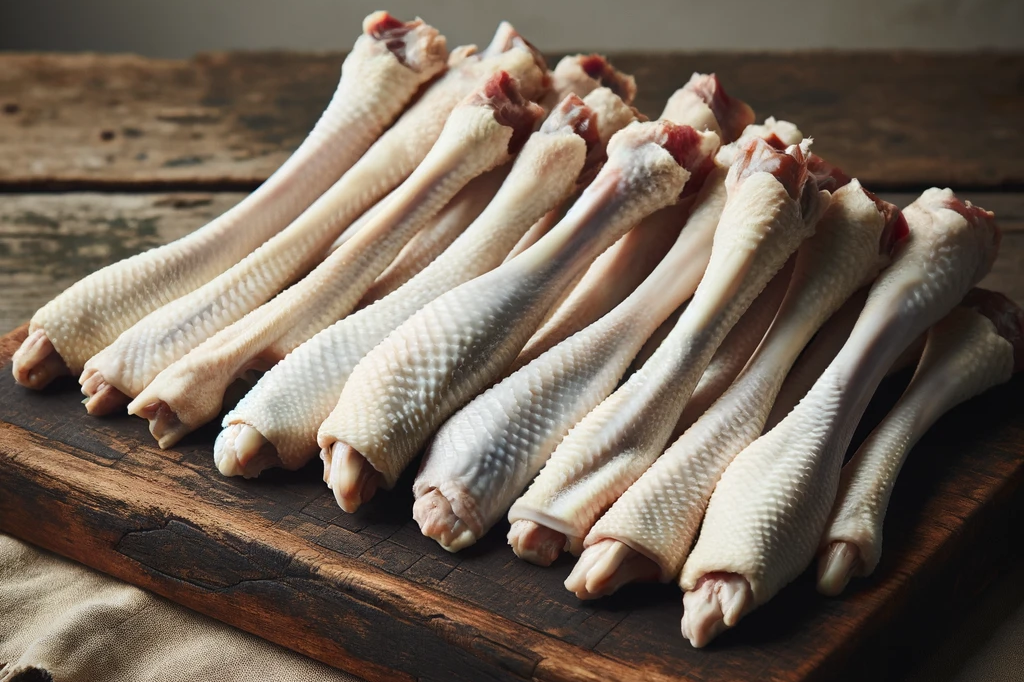Chicken thigh bone

You may have heard that chicken thigh bones can be a good addition to your dog's food. But is that really true? And what should you look out for when giving your four-legged friend chicken thigh bones? In this article, you'll find out everything you need to know about this ingredient.
What are chicken thigh bones?
Chicken thigh bones are the bones from the lower part of the chicken leg. They consist of a long tubular bone and a short jointed bone. The bones are surrounded by meat, skin and cartilage. Chicken thigh bones are available in many supermarkets and butchers. You can buy them raw or cooked.
What are the benefits of chicken thigh bone for dogs?
Chicken thigh bones can have several benefits for your dog's health and well-being. For one thing, they contain a lot of protein, calcium and phosphorus, which are important for building muscles, bones and teeth. Secondly, they can strengthen the chewing muscles and promote dental hygiene by removing tartar and plaque. They can also provide your dog with activity and fun by satisfying his natural urge to chew.
What are the disadvantages of chicken thigh bones for dogs?
Chicken thigh bones are not without risks for your dog. For one thing, they can cause injury to the mouth or digestive tract if they splinter or have sharp edges. Secondly, they can lead to digestive problems such as diarrhea or constipation if they are fed too much or too often. They can also lead to an overdose of calcium or phosphorus if they are not balanced with other nutrients.
How to feed chicken thigh bones correctly?
If you want to give your dog chicken thigh bones, you should follow some rules to minimize the risks and maximize the benefits. Here are some tips:
- Choose raw chicken thigh bones as they are less likely to splinter than cooked ones.
- Make sure the bones are fresh and have no signs of mold or spoilage.
- Do not cut the bones into small pieces or remove the skin or cartilage, as these parts help to soften the bones.
- Only give your dog as much chicken thigh bone as he can eat in one meal. The amount will depend on your dog's size and weight, but a rule of thumb is about 10% of their daily calorie requirements.
- Reduce the amount of other food accordingly to avoid overfeeding.
- Always give your dog fresh water when he eats bones.
- Always supervise your dog when he eats bones and remove any scraps or splinters immediately.
- Do not feed your dog chicken thigh bones more than two to three times a week.
Chicken thigh bones are the bones from the lower part of the chicken leg and can be bought raw or cooked. They are rich in protein, calcium and phosphorus, which is good for your dog's muscles, bones and teeth. They also promote chewing muscles and dental hygiene. However, there are risks such as injuries to the mouth or digestive problems if the bones splinter or too much is fed. It is important to choose the right amount, pay attention to freshness and quality and supervise your dog when eating.
If you notice any signs of hypersensitivity or poisoning in your dog, you should see your vet immediately. We are not a substitute for a vet, but we try to be as accurate as possible. Every dog reacts differently and we recommend you get a second opinion or consult your vet if in doubt.
Stay healthy and take good care of your four-legged friend!😊
Similar to Chicken thigh bone
Duck thigh bones are exactly what their name suggests: the bones from the thighs of ducks. They can be offered raw, cooked or dried and are considered a tasty and nutritious addition to regular dog...
Goose thigh bones are the hard structures that form the lower part of a goose's leg. After the meat has been removed for human consumption, the bones often remain, which at first glance appear to be...
Pigeon thigh bones are, as the name suggests, the bones from the thighs of pigeons. They are usually found in dogs' diets as part of a raw meat diet (BARF - Biologically Appropriate Raw Food). Their...
Turkey thigh bones are the bones found in the lower part of the turkey leg, an area known for its dark, flavorful meat. While the meat is a popular source of protein, the bones themselves draw a...


